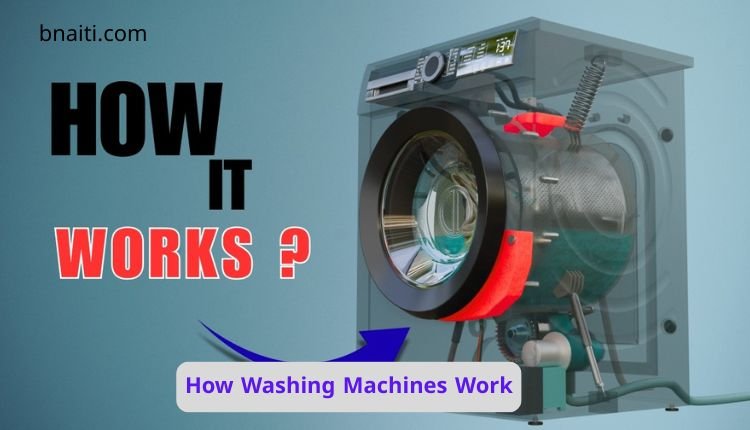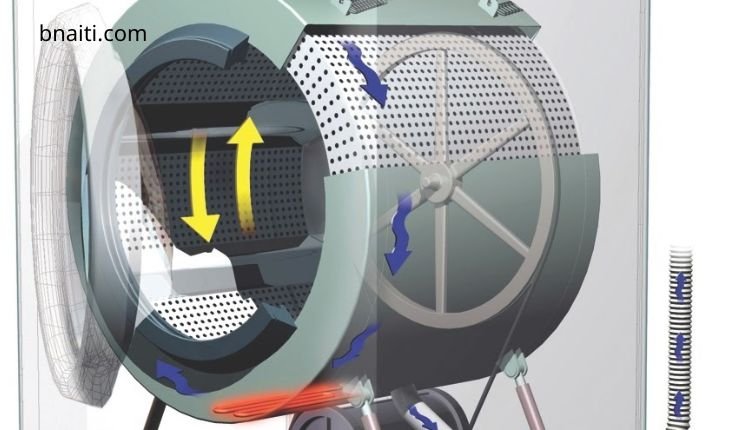How Washing Machines Work: The Science Behind Cleaning Clothes

Washing clothes may seem like a simple task today—just toss them into a machine, add detergent, and press start. But behind that everyday convenience lies a remarkable combination of chemistry, physics, and modern engineering.
Whether it’s a top load or front load washing machine, both operate on the same core principles: water, detergent, motion, and centrifugal force. Yet, the technology that makes it all possible is far more sophisticated than it appears.
In this comprehensive guide, I’ll explain how washing machines really work, why detergent plays the starring role, how top load and front load systems differ, and what keeps these machines from shaking themselves apart during the spin cycle.
The True Role of Detergent in Cleaning Clothes
Most people believe the washing machine is what removes dirt and stains from fabric. In reality, the real hero is the detergent. The machine’s primary job is to replicate the physical motions we used to perform by hand—rubbing, rinsing, and squeezing—while allowing detergent to do the chemical work.
At a microscopic level, fabric fibers contain tiny pores and surfaces where oil, dust, and sweat particles attach. These oil particles are especially stubborn because they don’t dissolve in water. This is where detergent comes in.
Detergent molecules are composed of two main parts: a hydrophilic head that loves water and dissolves easily in it, and a hydrophobic tail that repels water but is drawn to oil and grease. When detergent is added to water, the hydrophobic tail attaches itself to oily residues on the fabric. The hydrophilic head then pulls the entire molecule into the water, breaking down the grease and lifting it away from the fabric surface.
If the machine heats the water, the cleaning process becomes even more effective. Heat causes the fabric pores to expand, allowing detergent to penetrate deeper and soften tough stains. This is why washing with warm or hot water often results in a noticeably cleaner load.
Detergents also contain enzymes and other specialized components designed to tackle various types of stains, such as protein-based stains from sweat, dirt particles, or color pigments. Each of these works by the same general principle—breaking down complex substances into smaller, water-soluble molecules that can be easily rinsed away.
Simply put, detergent cleans; the machine assists. Without detergent, even the most advanced washing machine would struggle to deliver spotless results.
The Engineering Behind Washing Machines
The washing machine’s mechanical design is a masterpiece of practical engineering. Its primary purpose is to ensure that water and detergent circulate evenly through the clothes, maximizing contact and cleaning power. To achieve this, the machine creates controlled movement and agitation using motors, sensors, and rotational dynamics.

Modern machines—both top load and front load—share a similar process:
- Filling with water
- Mixing detergent
- Agitating clothes for cleaning
- Rinsing to remove detergent
- Spinning to extract excess water
However, the way they perform these steps differs significantly depending on whether the machine is a top load or a front load design.
“Read Also: Best 8 KG Top Load Washing Machines“
Top Load Washing Machines: Simplicity and Speed
Top load washing machines are among the most common household appliances, especially in regions where convenience and shorter washing times are valued. Their defining feature is the vertical drum—a large cylindrical tub that spins around a central axis.
When you place clothes inside and start the wash cycle, the drum begins spinning at speeds typically between 600 to 800 RPM. As the machine accelerates, you might notice the clothes shifting and bunching up on one side. This uneven distribution creates an imbalance, causing the drum to vibrate or even move slightly during high-speed spinning.
Despite this, top load washers remain popular due to their straightforward design and affordability.
The Pulsator and Motor System
At the bottom of a top load washing machine is a pulsator—a disc-shaped component that moves clothes back and forth. This pulsator is powered by a BLDC (Brushless DC) motor, a modern replacement for older universal or induction motors.
The BLDC motor offers greater efficiency and precise control. It can rotate the pulsator in both clockwise and counterclockwise directions by changing the phase sequence of the electrical current. A dedicated electronic controller manages this switching, ensuring the pulsator moves smoothly and effectively agitates the clothes.
Inside the motor, a rotor fitted with permanent magnets interacts with a stator containing electrical coils. When current flows through the coils, they generate magnetic poles that attract and repel the magnets on the rotor, creating rotation. By continuously alternating the current between coils, the controller keeps the rotor spinning—similar to a carrot dangling in front of a moving donkey, always motivating it to move forward.
Reversing the current reverses the motor’s direction, giving the machine flexibility during different stages of the wash.
How Clothes Are Washed in a Top Load Machine
As the pulsator moves, it creates a dynamic water flow that causes clothes to rub against each other. This friction helps lift dirt from fibers while ensuring detergent is evenly distributed. However, this agitation can also be harsh on delicate fabrics, leading to wear and tear over time.
While efficient in cleaning, top load washing machines tend to consume more water and energy compared to front load models. On the plus side, they allow users to add clothes mid-cycle and offer shorter wash times.
“Read Also: Microwave vs. Air Fryer“
Front Load Washing Machines: Efficiency and Precision
Front load washing machines represent a more advanced approach to fabric care and energy efficiency. The key difference lies in the horizontal rotation of the drum. Unlike top load models, the drum in a front load machine rotates on a side-mounted axis, driven by a motor and pulley system located at the rear.
Interestingly, front load machines use two drums—an inner drum and an outer drum. The outer drum remains fixed and holds water, while the inner drum rotates and contains the clothes. The space between these drums is essential for collecting and draining water.
The Intelligent Water Filling System
You might assume that washing machines use a scale to measure the water level, but they don’t. Instead, they rely on air pressure sensors. As water fills the outer drum, the trapped air inside compresses, increasing air pressure. The sensor monitors these changes to determine when the right amount of water has been added.
Once the door is locked and the correct water level is reached, the machine can activate a heating element if necessary. Heating the water helps dissolve detergent faster and improves the breakdown of tough stains.
The Tumbling Effect: Gentle Yet Effective Cleaning
Front load machines do not use pulsators or agitators. Instead, the drum’s interior surface has small raised ridges that lift clothes upward during rotation. When gravity pulls them back down, they fall into the water, creating a tumbling action.
This tumbling mimics the traditional hand-washing motion but is far gentler on fabrics. As clothes fall through water repeatedly, detergent circulates more evenly, cleaning every fiber with precision.
Because of this efficient design, front load machines use up to 60% less water than top load models. The absence of a central agitator also means there’s more room inside for larger loads.
“Read Also: refrigerator and freezer thermostat“
The Spin Cycle and Centrifugal Force
After washing and rinsing, the machine begins the spin cycle to remove excess water. During this phase, the inner drum spins at high speeds—often up to 1,200 RPM or more. The rapid rotation generates centrifugal force, which pushes water out of the clothes and through tiny holes in the drum’s walls.
The extracted water collects in the outer drum and is pumped out via the drainage system. The result is semi-dry laundry that dries much faster once removed.
However, this is also when vibration becomes a major issue, particularly in front load machines.
Managing Vibration in Front Load Washing Machines
During the spin cycle, all the clothes naturally settle at the bottom of the drum. Unlike top load machines, where clothes can be distributed evenly around the axis, front load machines can’t balance their loads perfectly. This uneven weight distribution leads to strong vibrations, especially during high-speed spinning.
To combat this, front load machines use an impressive system of suspension and damping. Both the inner and outer drums are suspended within the machine’s frame using springs and shock absorbers.
The Suspension and Counterweight System
Springs attached to the top of the drum help absorb vertical movement, while dampers at the bottom absorb horizontal vibrations. Still, this isn’t always enough. That’s why heavy counterweights—usually made of concrete or cast iron—are mounted on both the top and bottom of the drum assembly.
These counterweights act as stabilizers, offsetting the drum’s vibrations by providing opposing inertia. Essentially, they help keep the machine firmly in place. Without them, the machine could literally shake or “walk” across the floor during operation.
This complex balancing system is one reason front load washing machines tend to be heavier than top load ones.
Why Front Load Machines Are More Efficient
Despite their heavier weight and higher price, front load washers are widely recognized for their superior performance. Here’s why:

- Water efficiency: They use significantly less water because the horizontal drum allows for effective cleaning even with a shallow water level.
- Energy savings: Less water means less energy required for heating.
- Fabric care: The tumbling motion is gentle on clothes, preserving their texture and color for longer.
- Better spin performance: Higher spin speeds extract more water, reducing drying time.
On the other hand, top load machines are easier to load and unload, require less bending, and typically have shorter wash cycles. The choice between the two depends on user preferences, space availability, and lifestyle.
The Future of Washing Machine Technology
Modern washing machines are becoming smarter and more connected. Today’s models include AI-based load sensors, automatic detergent dispensers, and Wi-Fi connectivity that allows users to control wash cycles from their smartphones.
Some manufacturers are experimenting with ultrasonic cleaning—using sound waves to break down stains at the molecular level—or steam-assisted washing, which sanitizes clothes without the need for extremely high temperatures.
Despite these innovations, the fundamental science behind washing—using detergent, water, and controlled movement—remains unchanged.
Common Misconceptions About Washing Machines
Even with all this technology, many people misunderstand how washing machines work. Here are a few key clarifications:
- Myth: More detergent means cleaner clothes.
Truth: Too much detergent can actually make rinsing harder, leaving residue on fabrics. - Myth: Cold water cleans just as well as hot.
Truth: While modern detergents are improving, warm water still performs better for greasy or oily stains. - Myth: Vibration means your machine is broken.
Truth: Some vibration is normal, especially during spin cycles. Proper leveling and balanced loads can minimize it.
Conclusion: A Perfect Blend of Science and Engineering
The washing machine is a prime example of how engineering and chemistry work together to simplify everyday life. By combining mechanical motion, intelligent design, and chemical reactions, it replaces the strenuous task of hand washing with effortless efficiency.
Whether you prefer the convenience of a top load washer or the efficiency of a front load model, both operate on the same timeless principles—agitation, detergent, water, and spin. The next time you hear your washing machine humming in the background, you’ll know it’s not just spinning clothes—it’s demonstrating centuries of scientific innovation in action.



